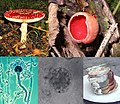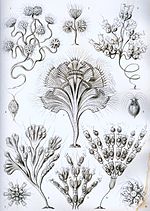A zoospore is a motile asexual spore that uses a flagellum for locomotion in aqueous or moist environments. Also called a swarm spore, these spores are...
7 KB (747 words) - 18:06, 19 April 2024
reproductive zoosporangium and a motile, uniflagellated zoospore released from the zoosporangium. The zoospores are known to be active only for a short period...
39 KB (4,422 words) - 21:14, 13 July 2024
meaning "little pot", describing the structure containing unreleased zoospores. Chytrids are one of the earliest diverging fungal lineages, and their...
30 KB (2,803 words) - 17:09, 3 August 2024
Saprolegnia releases zoospores. Within a few minutes, this zoospore will encyst, germinate and release another zoospore. This second zoospore has a longer cycle...
6 KB (545 words) - 08:30, 23 April 2024
12–18 °C (54–64 °F) in water-saturated or nearly saturated environments, and zoospore production is favored at temperatures below 15 °C (59 °F). Lesion growth...
75 KB (7,618 words) - 10:13, 25 July 2024
zoosporangium and motile zoospore stages, though seen in zooxanthellae life cycles, are much rarer amongst clades. The zoospore resides in the zoosporangium...
24 KB (2,742 words) - 03:57, 15 June 2024
sporangia may release zoospores, which have two unlike flagella which they use to swim towards a host plant. Zoospores (and zoospores of Pythium, also in...
30 KB (2,372 words) - 08:03, 5 June 2024
It is used in the Engler system. Asexual reproduction takes place by zoospores (motile) or by Aplanospores (non-motile). These spores are endogenously...
3 KB (230 words) - 15:26, 2 July 2024
zoosporangium (holocarpic), and do not release zoospores through a lid-like structure (inoperculate). Zoospores of other members of Chytridiomycota typically...
16 KB (1,986 words) - 21:31, 25 April 2024
protrudes from certain plant and animal sperm cells, from fungal spores (zoospores), and from a wide range of microorganisms to provide motility. Many protists...
65 KB (7,151 words) - 19:55, 31 July 2024
populations. These organisms spend part of their life cycle as a motile zoospore, enabling them to propel themselves through water and enter their amphibian...
201 KB (19,177 words) - 01:12, 28 July 2024
brown algae (zoospores and gametes), oomycetes (assexual zoospores and gametes), hyphochytrids (zoospores), labyrinthulomycetes (zoospores), some chrysophytes...
13 KB (1,350 words) - 03:43, 17 June 2024
involves the formation of chlamydospores and sporangia, producing motile zoospores. Oomycetes occupy both saprophytic and pathogenic lifestyles, and include...
20 KB (1,669 words) - 09:35, 2 May 2024
species with a Group I-type zoospore, distinguishing it from Chytridiaceae members, which have a Group II-type zoospore. J. S. Karling circumscribed...
5 KB (371 words) - 18:24, 24 May 2024
particularly the cellulolytic bacteria, lower protozoa, and higher fungi zoospores. In addition, higher levels of the rumen ammonia nitrogen (NH4-N) and...
84 KB (9,081 words) - 01:48, 6 August 2024
B. dendrobatidis, a waterborne pathogen, disperses zoospores into the environment. The zoospores use flagella for locomotion through water systems until...
54 KB (5,910 words) - 17:09, 3 August 2024
pathogens such as Phytophthora and Rhizoctonia. Pythium wilt is caused by zoospore infection of older plants, leading to biotrophic infections that become...
12 KB (1,152 words) - 08:02, 5 June 2024
including their cell wall made of extracellular non-cellulosic scales, zoospores with characteristic heterokont flagella, and a bothrosome-produced ectoplasmic...
104 KB (10,658 words) - 15:08, 11 April 2024
Neocallimastix patriciarum (section Zoospore)
patriciarum in Chytridiomycota was primarily due to the presence of flagellated zoospores, a defining characteristic of the Chytridiomycota phylum. Neocallimystigomycota...
13 KB (1,400 words) - 17:13, 16 January 2024
estuaries. It obtains nutrients from the host alga and produces swimming zoospores that must survive in open water, a low nutrient environment, until a new...
56 KB (5,794 words) - 22:57, 14 August 2024
begins with the motile Aphelidium zoospore contacting its host, a green alga. The singular flagellum of the zoospore is lost as part of the attachment...
7 KB (806 words) - 19:36, 1 February 2024
germinate to produce macrosporangia, which under wet condition release zoospores. Zoospores are splashed by rain into the canopy, where they swim to and infect...
28 KB (3,426 words) - 14:43, 5 May 2024
The sporangia ripen and release zoospores, which infect plant roots by entering the root behind the root tip. Zoospores need water to move through the...
20 KB (2,029 words) - 18:14, 13 August 2024
accessible as a resource for teachers. "Zoospore ultrastructure of Monoblepharis polymorpha", Journal Mycologia, 1994 “Zoospore ultrastructure of Gonapodya polymorpha”...
5 KB (418 words) - 05:32, 19 January 2024
while in storage. Zoospores are motile asexual spores that can move through soil water through the use of their flagella. These zoospores are also capable...
13 KB (1,489 words) - 20:01, 23 October 2023
cellulose and the outer layer of pectose. Asexual reproduction is by zoospores. They are flagellates produced from the parent cells by mitosis. Also...
8 KB (1,071 words) - 16:42, 13 August 2024
flagella) zoospores formed by the thousands inside a cell. However, the zoospores hardly move, as they are packed very densely. The zoospores form a cell...
3 KB (307 words) - 20:25, 18 December 2023
Thraustochytriidae SEM image of a Phycophthorum zoospore Scientific classification Domain: Eukaryota Clade: Diaphoretickes Clade: SAR Clade: Stramenopiles...
5 KB (434 words) - 19:34, 7 May 2024
Noctiluca scintillans (section Zoospores)
progenitors. The progenitors of the previous stage have transformed into zoospores. At this point they are evenly distributed in one part of the cell. At...
30 KB (3,598 words) - 15:20, 26 June 2024



























